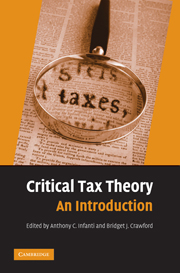Book contents
- Frontmatter
- Contents
- List of Illustrations
- List of Tables
- List of Contributors
- List of Common Abbreviations
- Introduction
- CHAPTER 1 FOUNDATIONS OF CRITICAL TAX THEORY
- CHAPTER 2 HISTORICAL PERSPECTIVES ON TAXATION
- CHAPTER 3 THE GOALS OF TAX POLICY
- CHAPTER 4 CRITICAL TAX THEORY MEETS PRACTICE
- CHAPTER 5 RACE AND TAXATION
- CHAPTER 6 GENDER AND TAXATION
- CHAPTER 7 SEXUAL ORIENTATION AND TAXATION
- CHAPTER 8 THE FAMILY AND TAXATION
- Love, Money, and the IRS: Family, Income-Sharing, and the Joint Income Tax Return
- Innocent Spouses: A Critique of the New Tax Laws Governing Joint and Several Tax Liability
- Taxation and the Family: A Fresh Look at Behavioral Gender Biases in the Code
- The Profits and Penalties of Kinship: Conflicting Meanings of Family in Estate Tax Law
- The Tax Treatment of Children: Separate but Unequal
- Rocking the Tax Code: A Case Study of Employment-Related Child-Care Expenditures
- CHAPTER 9 CLASS AND TAXATION
- CHAPTER 10 DISABILITY AND TAXATION
- CHAPTER 11 GLOBAL CRITICAL PERSPECTIVES ON TAXATION
- CHAPTER 12 CRITICAL PERSPECTIVES ON CRITICAL TAX THEORY
- Index
Rocking the Tax Code: A Case Study of Employment-Related Child-Care Expenditures
Published online by Cambridge University Press: 04 August 2010
- Frontmatter
- Contents
- List of Illustrations
- List of Tables
- List of Contributors
- List of Common Abbreviations
- Introduction
- CHAPTER 1 FOUNDATIONS OF CRITICAL TAX THEORY
- CHAPTER 2 HISTORICAL PERSPECTIVES ON TAXATION
- CHAPTER 3 THE GOALS OF TAX POLICY
- CHAPTER 4 CRITICAL TAX THEORY MEETS PRACTICE
- CHAPTER 5 RACE AND TAXATION
- CHAPTER 6 GENDER AND TAXATION
- CHAPTER 7 SEXUAL ORIENTATION AND TAXATION
- CHAPTER 8 THE FAMILY AND TAXATION
- Love, Money, and the IRS: Family, Income-Sharing, and the Joint Income Tax Return
- Innocent Spouses: A Critique of the New Tax Laws Governing Joint and Several Tax Liability
- Taxation and the Family: A Fresh Look at Behavioral Gender Biases in the Code
- The Profits and Penalties of Kinship: Conflicting Meanings of Family in Estate Tax Law
- The Tax Treatment of Children: Separate but Unequal
- Rocking the Tax Code: A Case Study of Employment-Related Child-Care Expenditures
- CHAPTER 9 CLASS AND TAXATION
- CHAPTER 10 DISABILITY AND TAXATION
- CHAPTER 11 GLOBAL CRITICAL PERSPECTIVES ON TAXATION
- CHAPTER 12 CRITICAL PERSPECTIVES ON CRITICAL TAX THEORY
- Index
Summary
Through an examination of the tax law's treatment of child-care expenditures, I intend to show both how the current tax law facilitates class, gender, and race subordination and how it could be designed to disrupt it. By looking at the tax law's treatment of employment-related child-care expenditures, I will make the argument that a comprehensive tax analysis requires not only an examination of the well-recognized issues of equity, administrability, and economic rationality, but also consideration of other issues of social justice – specifically, consideration of the implications of economic exploitation, racism, and sexism on economic arrangements.
The conventional tax analysis of child-care provisions focuses exclusively on the effects of the provisions on the parents, usually mothers, to engage in waged work. Little or no consideration is given in traditional tax analysis on the effects of the provisions on the waged child-care worker. This omission is particularly confounding because the economic arrangement that is the very subject of taxation is the purchase of child-care services. The antisubordination principle, which is based on the proposition that economic exploitation, sexism, and racism operate together, holds out the promise of uncovering this type of analytical shortcoming and thereby enhancing our understanding of the economic implications of a tax rule.
CURRENT TAX TREATMENT OF EMPLOYMENT-RELATED CHILD-CARE EXPENDITURES
Section 21 provides a nonrefundable credit equal to between 20% and 30% of the expenditures incurred for child care during the taxable year that enable the taxpayer to be gainfully employed. The percentage of expenditures allowed varies depending on the taxpayer's adjusted gross income.
- Type
- Chapter
- Information
- Critical Tax TheoryAn Introduction, pp. 261 - 268Publisher: Cambridge University PressPrint publication year: 2009
- 2
- Cited by



